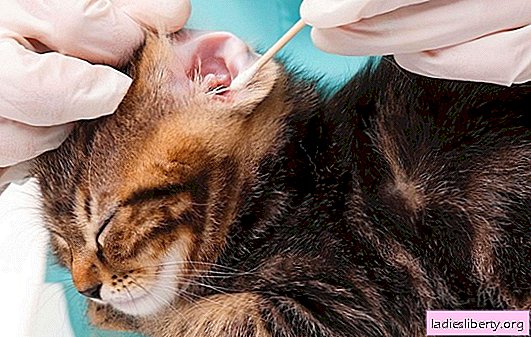
Childbirth, as a natural process, often leads to injuries in the mother and child. The child, passing through the birth canal, overcomes strong bone resistance in the presence of a narrow pelvis in the mother. In this case, the development of cephalohematoma is possible - between the bone of the skull of the newborn and the periosteum, blood accumulates.
According to statistics, Kefalogematoma occurs with a frequency of: 2 per 100 genera. It is believed that this is the most frequently encountered birth injury.
Kefalogematoma formation
Anatomically, the periosteum is a thin plate consisting of connective tissue. It is attached to the bone strictly along its edge. Therefore, the cephalohematoma does not go beyond the boundaries of one skull bone: frontal, occipital, temporal, parietal. During childbirth, several such hematomas can occur - but within different bones. At the same time, two cephalohematomas over one of the bones of the skull do not appear.
This hemorrhage is diagnosed 24-48 hours after birth. It looks like a soft - elastic swelling on the parietal (much less often - on the occipital or frontal) bone. On palpation, fluid transfusion is felt. The formation can be painful and cause a negative reaction of the child due to a bone fracture arising under it. If this did not happen, the pain does not appear. The skin over the formation is not changed. Sizes of cephalohematomas vary:
• up to 4cm - first degree;
• 4.1 - 8 cm - the second degree;
• more than 8cm - 3 degree.
The hemorrhage can reach 20 cm. If there are several of them, the entire joint area is summed up. One hematoma contains from 5 to 200 ml of blood, which, due to the lack of coagulation factors in newborns, does not clot for a long time. In this regard, during the first days of education can increase.
Cephalohematomas, as indicated, can be accompanied by tissue damage.
These include:
• fractures of the skull bones;
• cerebral edema, cerebral hemorrhage.
Such complications, according to statistics, are observed in 5 newborns out of 1000.
Cephalohematoma in a newborn - causes
Cephalohematoma occurs in the birth process, when, overcoming the resistance of the pelvic bones, the bones of the skull are compressed, the skin moves, the vessels are damaged.
The reasons for it may be different. On the part of the mother:
• narrow pelvis;
• maternity allowance using traumatic medical instruments (forceps or a vacuum extractor);
• quick or prolonged labor;
• age after 35 years;
• first birth.
Causes of cephalohematoma in a newborn:
• big weight (more than 4 kg);
• pathological presentation;
• malformations of organs (hydrocephalus);
• pregnancy over 40 weeks (fetal bones become denser, which complicates the ability to change during childbirth);
• increased bleeding (hemophilia).
Rare causes of cephalohematoma in a newborn:
• entanglement of the umbilical cord, retraction of the tongue, leading to fetal hypoxia;
• aspiration of amniotic fluid.
Differential diagnosis
When revealing cephalohematomas, despite the uncomplicated diagnostic process, they are differentiated from:
• aponeurotic hemorrhage;
• birth tumor;
• a hernia of the brain.
Aponeurosis hemorrhage has no clear boundaries, can spread to the area of several bones at once, more dense to the touch.
The birth tumor is, in fact, edema of the subcutaneous tissue. It can occupy space over an area of more than one bone, without obvious boundaries, with a jelly-like consistency, passes in 3 days.
A hernia is a protrusion of the meninges (and, in some cases, brain tissue) through the sutures of the skull or fontanel.
Kefalogematoma in a newborn - consequences
The prognosis for this pathology is favorable: a cephalohematoma does not affect the development of the child and his intelligence.
The consequences that may occur in a newborn:
• ossification;
• anemia;
• jaundice;
• suppuration.
Ossification
One week after birth, dense connective tissue can grow at the site of the hematoma. As a result, the skull bone is deformed, since the resulting tissue has a high density. But this is only a cosmetic defect that does not affect the state of health. It will be completely invisible in an adult.
Anemia
If the hematoma is large or in the presence of several formations, posthemorrhagic anemia may develop. This is due to the small amount of blood in the newborn, which significantly affects any loss. There is no treatment for such anemia: as a rule, hemoglobin is restored to normal over time without taking special medications.
With the breakdown of red blood cells, hemolytic anemia develops with its external manifestation in the form of jaundice.
Jaundice
In those cases when the cephalohematoma is huge in size and at the same time quickly resolves, red blood cells decay. Blood bilirubin level rises, hemolytic anemia develops. Since metabolic processes are slowed down, for some time the skin and mucous membranes have a slight icteric staining. Special therapy in such cases is not prescribed, the condition normalizes independently.
Suppuration
One of the rare but formidable complications is suppuration, which occurs when the integrity of the hematoma is damaged and its infection. It is dangerous because the inflammatory process can go to the brain tissue. If suppuration has occurred, the condition of the newborn worsens: body temperature, the child becomes lethargic and restless. The skin over the hematoma becomes inflamed, becomes red, swollen, painful. Palpation causes anxiety and crying.
In the case of the development of such a complication, an emergency operation is performed: opening, drainage, then a course of anti-inflammatory local therapy. With the timely detection of pathology, everything goes without consequences for the health of the child.
What to do with a cephalohematoma in a newborn
Kefalogematoma, if its integrity is not broken, does not pose a threat to the health and life of the newborn. It is believed that a 8 cm hematoma does not require medical intervention and resolves itself over time.
Therapeutic treatment
In the presence of such a hematoma, the pediatrician can prescribe vitamins (vitamin K) to strengthen the walls of blood vessels and reduce bleeding, as well as calcium preparations. Sometimes for topical administration Troxevasin - gel is attributed. It is approved for use by newborns, applied to the scalp twice a day.
Puncture
With sizes greater than 8 cm, a puncture is performed, the contents are aspirated, a tight, pressure bandage is applied to the puncture site. A child surgeon and a neonatologist observe the child. Puncture is carried out on 10 - 20 days. There is another indication for the puncture: the absence of a reduction in the size of the cephalohematoma by 10 days.
Some experts advise puncturing the hematoma after childbirth, without waiting for complications. There is no consensus on this. The issue of medical tactics is decided individually. A puncture is still necessary according to strict indications. If you can do without it, it is better to refrain from unnecessary interference. But you can’t refuse it, if the need is justified. A puncture will prevent the development of serious complications in the form of suppuration.
Excision
If necessary, the ossified hematoma is also treated surgically - the ossified part is excised, after which the wound edges are sutured.
Every mom needs to know:
• you can not rock the child with a hematoma up to 6 months - this slows down the resorption process;
• bathe the child very carefully to prevent damage to the skin and its infection;
• if surgery is necessary, do not refuse the operation - it is safe;
• if there are indications for cesarean section, it is necessary to leave the choice of birth management to the doctor and agree.
It is impossible to completely eliminate the formation of cephalohematomas in childbirth. But to make sure that the child develops correctly in utero and is born healthy, any woman can do. To do this, you need to eat right, take vitamins for pregnant women, give up bad habits, observe a regime of rest and sleep, walk a lot in the fresh air. Under these conditions, the child will be well developed, and the birth process will take place without complications.











